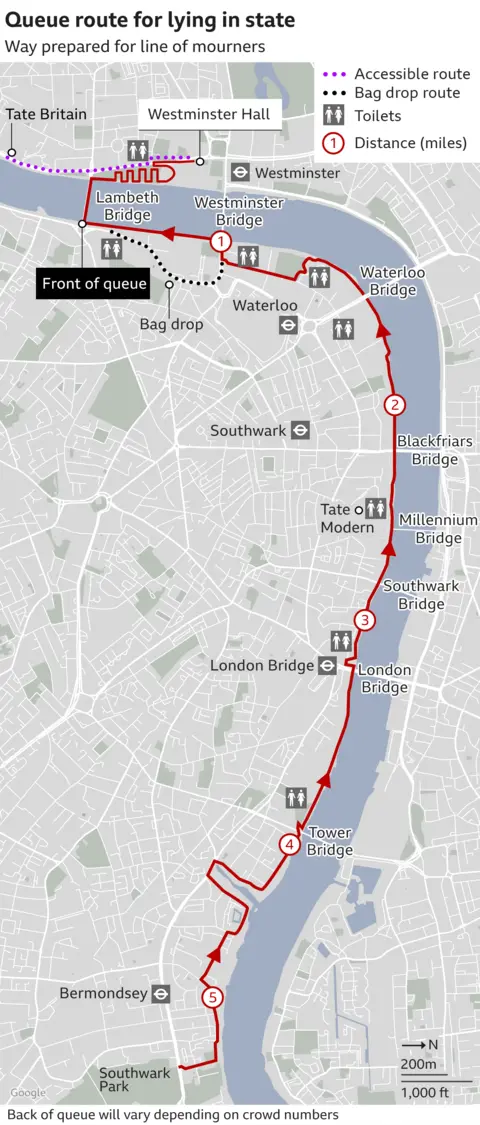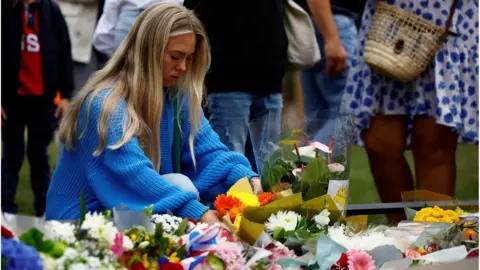Queen's lying-in-state: How long was the queue?
 Reuters
ReutersThere were huge queues along the banks of the River Thames, where people waited to pay their respects to the Queen.
People were told not to set off to see the lying-in-state on Sunday, as the queue reached full capacity. Just after 22:40, the queue was closed to new entrants. At 06:30 BST on Monday the lying-in-state ended.
Here's what else you need you to know about the queue.
How long did people queue?
At its longest, the wait time was more than 24 hours.
The queue's maximum length was 10 miles - with 6.9 miles from Westminster to Southwark, and a three-mile zigzag queue in Southwark Park.
For updates, the government published a live queue tracker for people to follow on YouTube.
People were warned they would need to stand for many hours with little opportunity to sit down, as the queue is constantly moving.

When did the queue close?
On Sunday morning, the government tracker advised people not to set off to join the queue as the entry point might soon close. The queue finally closed late on Sunday evening.
People in the queue received coloured wristbands so they could leave for a drink, or go to the toilet, and then return.
Those in the queue were asked not to attempt to save a place for someone else, or leave personal items unattended, or put up tents.
As people passed through Albert Embankment they were directed across Lambeth Bridge, into Victoria Tower Gardens, towards Parliament.
They went through airport-style security before entering Westminster Hall, inside the Palace of Westminster.
How did people go to the toilet while queuing?
There were more than 500 portable toilets at various points along the route.
Local venues and museums - including the Southbank Centre, the National Theatre, BFI Southbank and Shakespeare's Globe - stayed open for extended hours and in some cases for 24 hours, for people to use their facilities.
When did the queue close?
Anyone hoping to pay their respects had until 06:30 BST on Monday when the lying-in-state ended.
But organisers warned the queue would be closed well before this so that people did not join the line and fail to reach Westminster Hall in time.
The announcement was published on government social media accounts at 22:41 on Sunday.
Was there disabled access?
The accessible queue reached full capacity at 16:44 on Saturday and was permanently closed, according to the organisers.
The Department for Digital, Culture, Media and Sport said that all time slots for the accessible queue had been allocated and it was permanently shut.
It also asked people not to attempt to join it.
The accessible queue had already been paused on on Friday evening, due to high demand, but entry resumed for several hours from midday on Saturday.
For anyone already allocated a time slot for the accessible queue, step-free access was available to Westminster Hall and guide dogs and other assistance dogs were allowed. British Sign Language interpreters were available.
Visitor assistants in Parliament guided wheelchair users and any people with mobility issues (and their carers) along a route to access Westminster Hall.
Were extra trains running?
Transport bosses confirmed extra train services would be running.
Transport for London said the Westminster area of London would be "exceptionally busy". People were asked to avoid driving into London if possible. Some roads were closed, especially around Westminster itself, which disrupted bus services.
Travel providers said the best way to get around central London was by using London Underground and rail services, although there was the possibility of temporary Tube station closures at short notice, along with special queuing arrangements.
Network Rail said that some London train stations, including King's Cross and London Victoria, would remain open for 24 hours to provide shelter for mourners waiting to take the train home. It added that many toilets, shops and restaurants within the stations would also stay open during this time.
Visitors were advised to plan ahead, check real-time travel information, and consider walking instead wherever possible.
People were also asked to avoid Green Park Tube station unless they needed step-free access.
Could people get a ticket?
There was no ticketing system.
There were a number of rules about what you could take into Westminster Hall, and how visitors should behave - there was further information on the Houses of Parliament website.
Did people need to bring ID?
People did not need to show formal identification to enter the hall, but airport-style security checks were in place.
 PA Media
PA MediaWhat could people take with them?
People were advised to check the weather conditions in advance, and dress accordingly.
They were also advised to bring:
- food and drink - although these would need to be consumed or thrown away before reaching the security checks
- any essential medication or equipment
- a portable mobile phone charger
What couldn't people take in?
There was detailed guidance about what cannot be brought into the hall, which included:
- flasks or non-clear bottles - only clear water bottles were allowed in
- flowers or other tribute items - flowers could be taken to the dedicated area in Green Park
- any sharp items including knives
- coolers, hampers, sleeping bags and other camping equipment
- non-foldable pushchairs
- banners, placards, flags, advertising or marketing messages
Any prohibited items would be confiscated and not returned. Police could also conduct security checks along parts of the queue.
Each person was only allowed to take in one small bag with a single opening or zip.
There was a bag-drop facility with limited capacity.
What were the rules once inside?
People were asked to respect the dignity of the event, and to remain silent while inside the Palace of Westminster and dress appropriately, Anyone wearing clothes with "political or offensive slogans" would not be allowed in.
Mobile phones and other electrical devices had to be turned off or put on silent mode.
Once inside Westminster Hall, the queue was divided to pass on either side of the catafalque, which is the raised platform where the closed coffin lies.
Visitors were asked to keep moving forward at all times while in line, until they have exited into Parliament Square.
Could people take photos?
Not inside. Filming, photography and the use of mobile phones or other devices was not allowed in the security search area or once inside the Palace of Westminster.
 Reuters
ReutersWhat if people needed medical help?
There were eight first aid stations run by St John Ambulance along the route. They were at Southwark Park, Potters Fields Park, the Tate Modern, the Southbank Centre, Belvedere Road, Archbishop's Park, Lambeth Palace and Victoria Tower Gardens.
And more than 1,000 volunteers, stewards and police officers were on hand to help anyone who needed it. Volunteers were from the Scouts, Girlguiding, Samaritans, the British Red Cross, First Aid Nursing Yeomanry and the Salvation Army.
Where could people get a drink?
There were water stations along the route, and venues and museums will provide refreshments.
What about the national silence?
A one-minute silence was held across the UK at 20:00 BST on Sunday 18 September, the night before the Queen's funeral. A two-minute silence will then be observed at the end of the Queen's funeral, at about 11:55 BST on Monday 19 September.
What about floral tributes?
Large numbers of floral tributes have been placed by the public at royal residences around the UK. The Royal Household has issued guidance on where they can be left:
- At Buckingham Palace, dedicated sites have been set up in Green Park and Hyde Park.
- At Windsor Castle, they can be left at Cambridge Gate on the Long Walk and at the Royal Family's Sandringham Estate in Norfolk, flowers can be left at the Norwich Gates.
- At Balmoral Castle, where the Queen died on Thursday, flowers can be left at the Main Gate. Aberdeenshire Council has asked people to use park and ride services from the nearby settlements of Braemar and Ballater as there is no road access at the moment.
- In Edinburgh, members of the public can lay flowers in the Physic Garden, next to the Abbey Strand Gate at the Palace of Holyroodhouse.
- At Hillsborough Castle flowers may be left on the Castle Forecourt, in front of the main gates.
- The Royal Parks said non-compostable items, such as teddy bears or plastic wrapping, should be avoided where possible.
Where can I sign a condolence book?
Many local authorities have set up books of condolence in libraries, town halls and other civic buildings.
You can use this link to find your local authority, then visit its website to find out what might be available near you.
How can I pay tribute online?
There is an online book of condolence on the Royal Family website which can be accessed by clicking here.
BBC News is also collecting your stories and memories of the Queen for our online tributes page - you can share your special moments with us via this online form.


